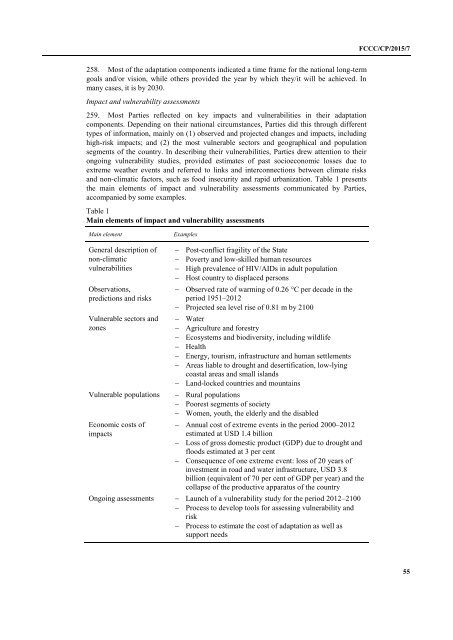FCCC/CP/2015/7
1PYuHQM
1PYuHQM
Create successful ePaper yourself
Turn your PDF publications into a flip-book with our unique Google optimized e-Paper software.
<strong>FCCC</strong>/<strong>CP</strong>/<strong>2015</strong>/7<br />
258. Most of the adaptation components indicated a time frame for the national long-term<br />
goals and/or vision, while others provided the year by which they/it will be achieved. In<br />
many cases, it is by 2030.<br />
Impact and vulnerability assessments<br />
259. Most Parties reflected on key impacts and vulnerabilities in their adaptation<br />
components. Depending on their national circumstances, Parties did this through different<br />
types of information, mainly on (1) observed and projected changes and impacts, including<br />
high-risk impacts; and (2) the most vulnerable sectors and geographical and population<br />
segments of the country. In describing their vulnerabilities, Parties drew attention to their<br />
ongoing vulnerability studies, provided estimates of past socioeconomic losses due to<br />
extreme weather events and referred to links and interconnections between climate risks<br />
and non-climatic factors, such as food insecurity and rapid urbanization. Table 1 presents<br />
the main elements of impact and vulnerability assessments communicated by Parties,<br />
accompanied by some examples.<br />
Table 1<br />
Main elements of impact and vulnerability assessments<br />
Main element<br />
Examples<br />
General description of<br />
non-climatic<br />
vulnerabilities<br />
Observations,<br />
predictions and risks<br />
Vulnerable sectors and<br />
zones<br />
Vulnerable populations<br />
Economic costs of<br />
impacts<br />
Post-conflict fragility of the State<br />
Poverty and low-skilled human resources<br />
High prevalence of HIV/AIDs in adult population<br />
Host country to displaced persons<br />
Observed rate of warming of 0.26 C per decade in the<br />
period 1951–2012<br />
Projected sea level rise of 0.81 m by 2100<br />
Water<br />
Agriculture and forestry<br />
Ecosystems and biodiversity, including wildlife<br />
Health<br />
Energy, tourism, infrastructure and human settlements<br />
Areas liable to drought and desertification, low-lying<br />
coastal areas and small islands<br />
Land-locked countries and mountains<br />
Rural populations<br />
Poorest segments of society<br />
Women, youth, the elderly and the disabled<br />
Annual cost of extreme events in the period 2000–2012<br />
estimated at USD 1.4 billion<br />
Loss of gross domestic product (GDP) due to drought and<br />
floods estimated at 3 per cent<br />
Consequence of one extreme event: loss of 20 years of<br />
investment in road and water infrastructure, USD 3.8<br />
billion (equivalent of 70 per cent of GDP per year) and the<br />
collapse of the productive apparatus of the country<br />
Ongoing assessments Launch of a vulnerability study for the period 2012–2100<br />
Process to develop tools for assessing vulnerability and<br />
risk<br />
Process to estimate the cost of adaptation as well as<br />
support needs<br />
55


